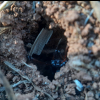Update 13 (04/06/2020)
Camponotus pennsylvanicus: I traded the Ponera pennsylvanica colony to a friend for a C. pennsylvanicus queen with a worker and some brood a few weeks ago, and tried to introduce the queen to this colony. Unfortunately it didn't go well, and the queen was killed. Fortunately, I found another queen a few days later (they must have had a small flight), and I am now trying to introduce her with a much more passive method than before.
Where earlier I'd introduced some small workers to the queen and then chilled the colony and the queen + workers before introducing the queen, this time I taped some wire mesh over the end of a test tube setup with the queen inside and I use some plasticine to secure the tube to an entrance hole in the side of the colony's nest. The workers have been very interested in the queen and the mesh, and the queen even laid an egg in this setup. The idea is that the colony will become accustomed to the queen's scent after a while, and eventually I'll be able to remove the mesh and allow her to wander into the colony. I'm being very cautious with this attempt, however. I don't want another dead queen on my hands.

As you can see, the queen is very pretty. She's a good size too, so I'm hoping everything goes well introduction wise. Otherwise, this colony is going to dwindle away to nothing, which would be a shame. Anyways, here are some more pics of the colony itself:



The colony still has lots of drone brood, and there are now lots of eclosed drones wandering around too. Not sure what I'll do about them, but they're pretty harmless, so I assume they won't be a problem when the queen is introduced.
Lasius minutus: Found this queen a week or two ago on a sunny day. She was likely out looking for some hosts. She's a neat goldish-yellow colour in the sunlight, which is what first caught my attention. She's also a good deal smaller than all the other Lasius spp. parasites I've seen before, only around 5-6mm long. I managed to find a bunch of niger-group workers and brood to introduce to her, and they've been doing well. The introduction went really well, with no fighting and minimal casualties. All of the host larvae I collected are also starting to pupate, so the worker force should increase dramatically in size soon. Hopefully then she'll lay some eggs. I know Lasius parasites can often lay large clutches of eggs, so I'm hoping the large amount of workers encourages her to do so.








This species is pretty interesting. In the wild, they build tall earthen mounds (up to 50cm in height if I remember correctly) in wet, swampy areas. They're also mainly subterranean in nature, which I hope won't pose a problem to their viability in captivity.
Pogonomyrmex occidentalis: Moved these guys out of their mini hearth, cause they were starting to outgrow it and they'd made a real mess of it. I couldn't even see into the nest it was so caked in gunk. I moved them into an outworld with sand and 3 test tubes (I used some old plastic ones cause I figured they'd make a mess of them anyways). They're still eating well and very active, but there isn't really much to see.



Lasius aphidicola: This colony is still doing alright. They're down to about a half dozen host workers, which isn't great, but they seem to have stabilized. I'll go and collect some more host brood for them I think, hopefully with a larger work force the queen will start laying.



Likely not gonna keep them if the L. minutus does well. Not sure I need more than one Lasiusparasite.
Formica aserva: ID'd this queen again yesterday just to be sure, we think she's still aserva. Also ID'd one of the workers (which came from my large formerly F. fusca-group colony), and we think they're Formica argentea. Still no luck with this colony. I saw a single pupa around a few days ago, but now it appears as though it's been eaten, which leaves this colony once again without brood and without biological workers. I'm not sure what the problem is, whether the queen's just not very good, or whether F. argentea make poor hosts. In any case, I'll try and collect some F. glacialis and F. ulkei brood after exams are over (so sometime next week) and introduce that to the colony to see if they get going.



Formica argentea: Still no more brood. I moved them into a mini hearth, but they haven't done much. I've heard that Formica colonies will stop laying for the whole year if they don't get enough food for a certain period of time. I'm hoping that's not the case, but it's happened with both of my Fusca-group colonies now, so who knows.
Formica fusca-group: Moved this "colony" back into a test tube. They're down to 2 workers and the queen, no brood. I'm tempted to throw them into the fridge for 3 or 4 months to test if the aforementioned theory is true. Really nothing else I can do at this point. They're given protein and sugar which they accept, but the queen hasn't laid any eggs in weeks, probably even months at this point.
Prenolepis imparis: These queens are still doing well. Can't quite see the brood pile, but it looks like it's either still eggs or small larvae. I'll just let them do their thing.
Stenamma brevicorne: Caught 7 of these queens a few weeks back, 1 escaped and 2 died, so now I'm down to 4. This is a cryptic species which I've been told maxes out at around 20 workers colony size-wise. Probably not going to keep them either. No brood yet, so I'll just let them do their thing too.
With the school year coming to a close and the province starting to open up a little bit, I should be able to make it out to the spot where I found Formica ulkei last year. From my research, it appears that they fly from early- to mid-July, so hopefully I'll be lucky enough to catch some flights. This is a really interesting species, and probably the last species I'm really looking to catch at this point. I'm trying to keep my permanent collection small with university in mind, so I'll probably limit it to 4 or 5 colonies. I'll probably raise anything else I catch over the summer, but I'm thinking I'll sell most of what I don't keep at the end of the year.
Anyways, that's it for this update. Stay tuned for the next one, which should hopefully include a successful Camponotus introduction (fingers crossed).












































